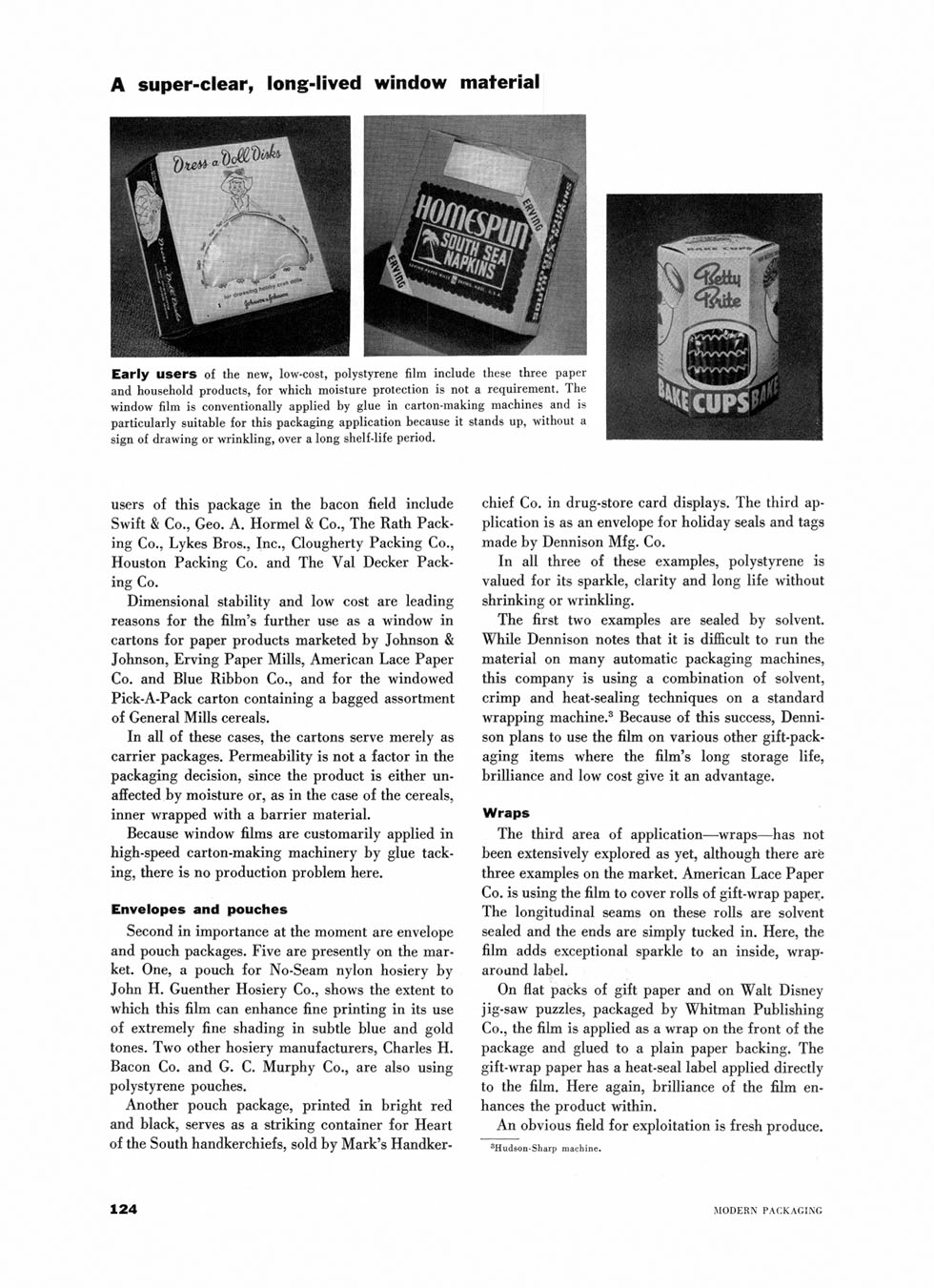


A super-clear, long-lived window material
Early users of the new, low-cost, polystyrene film include these three paper and household products, for which moisture protection is not a requirement. The window film is conventionally applied by glue in carton-making machines and is particularly suitable for this packaging application because it stands up, without a sign of drawing or wrinkling, over a long shelf-life period.
users of this package in the bacon field include Swift & Co., Geo. A. Hormel & Co., The Rath Packing Co., Lykes Bros., Inc., Clougherty Packing Co., Houston Packing Co. and The Yal Decker Packing Co.
Dimensional stability and low cost are leading reasons for the film's further use as a window in cartons for paper products marketed by Johnson & Johnson, Erving Paper Mills, American Lace Paper Co. and Blue Ribbon Co., and for the windowed Pick-A-Pack carton containing a bagged assortment of General Mills cereals.
In all of these cases, the cartons serve merely as carrier packages. Permeability is not a factor in the packaging decision, since the product is either unaffected by moisture or, as in the case of the cereals, inner wrapped with a barrier material.
Because window films are customarily applied in high-speed carton-making machinery by glue tacking, there is no production problem here.
Envelopes and pouches
Second in importance at the moment are envelope and pouch packages. Five are presently on the market. One, a pouch for No-Seam nylon hosiery by John IF Guenther Hosiery Co., shows the extent to which this film can enhance fine printing in Its use of extremely fine shading in subtle blue and gold tones. Two other hosiery manufacturers, Charles H. Bacon Co. and G. C. Murphy Co., are also using polystyrene pouches.
Another pouch package, printed in bright red and black, serves as a striking container for Heart of the South handkerchiefs, sold by Mark's Handker
chief Co. in drug-store card displays. The third application is as an envelope for holiday seals and tags made by Dennison Mfg. Co.
In all three of these examples, polystyrene is valued for its sparkle, clarity and long life without shrinking or wrinkling.
The first two examples are sealed by solvent. While Dennison notes that it is difficult to run the material on many automatic packaging machines, this company is using a combination of solvent, crimp and heat-sealing techniques on a standard wrapping machine.3 Because of this success, Dennison plans to use the film on various other gift-pack-aging items where the film's long storage life, brilliance and low cost give it an advantage.
Wraps
The third area of application wrap-”has not been extensively explored as yet, although there are three examples on the market. American Lace Paper Co. is using the film to cover rolls of gift-wrap paper. The longitudinal seams on these rolls are solvent sealed and the ends are simply tucked In. Here, the film adds exceptional sparkle to an inside, wraparound label.
On flat packs of gift paper and on Walt Disney jig-saw puzzles, packaged by Whitman Publishing Co., the film is applied as a wrap on the front of the package and glued to a plain paper backing. The gift-wrap paper has a heat-seal label applied directly to the film. Here again, brilliance of the film enhances the product within.
An obvious field for exploitation is fresh produce.
3Hudson-Sharp machine.